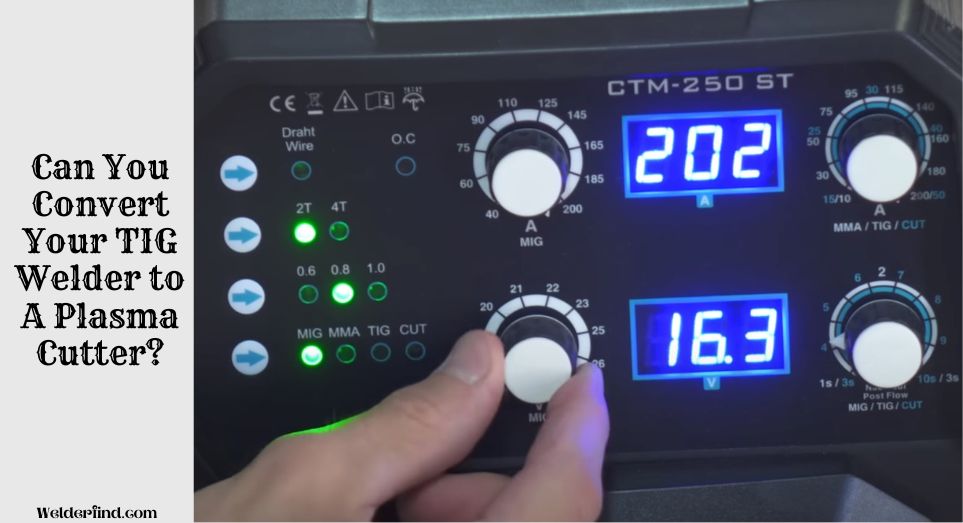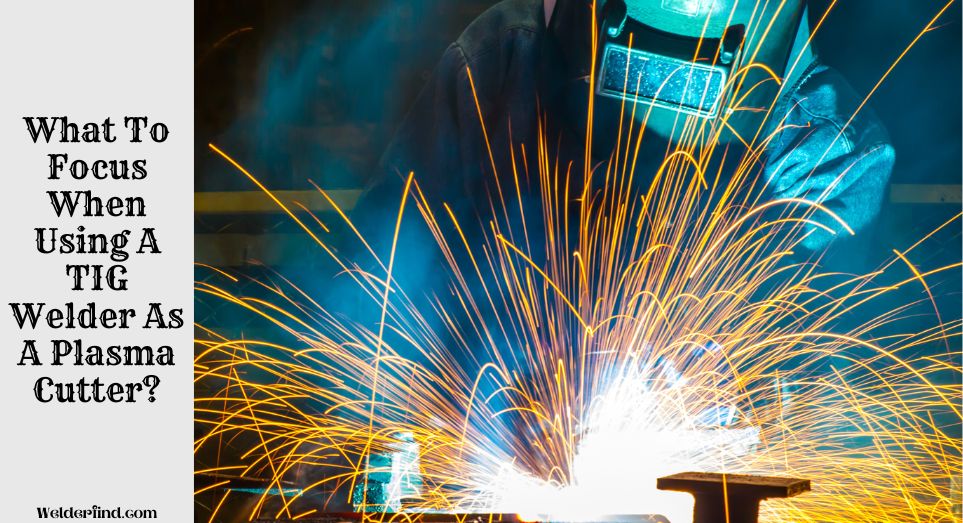Plasma cutters generate significantly higher output voltage than TIG welders. This allows its plasma torch to operate from a noticeable distance from the workpiece
But can you use a TIG welder as a plasma cutter? Yes! You can use it for a short-term purpose.
Don’t stop if you want to know how to do it!
Can You Convert Your TIG Welder to A Plasma Cutter?

It is best to use a multi-process machine that you can utilize for plasma cutting, TIG welding, and stick welding.
But you can still use a TIG welder as a plasma cutter if you are a bit cautious. One of the key points to remember is producing enough voltage without any electrocution.
Plasma cutting requires more heat output than welding workpieces.
Cautiousness is a must while using a TIG welder for plasma cutting, as no safety locks are present in a TIG welder like a plasma cutter.
How To Use A TIG Welder As A Plasma Cutter? – Step By Step Guide
As mentioned earlier, using either a plasma cutter or a multi-process machine for plasma cutting is best.
But you can use it at your own risk if you have no choice. Here are the steps to follow.
Step: 01—Choosing The Right Electrode
First, remove the default bulging electrode, as you need a much narrower, focused arc for plasma cutting.
Add an external 1/8” electrode that can handle high temperatures and high electrical conductivity.
Ensure the electrode is moderately sharpened for improved cut quality and stability.
Step: 02—Selecting The Maximum Flowmeter
The flowmeter in a TIG welder determines the flow rate of the purging gas
Plasma cutting requires a high-velocity gas flow with pressurized enough to create and maintain the plasma arc that cuts through the workpiece.
Besides, a higher gas flow rate used in plasma cutting also helps to cool the plasma torch and prevent overheating.
You can’t use the default flowmeter to cut plasma. Aim at choosing the maximum setting option to produce as much argon gas as possible.
Step: 03—Choosing The Right Amperage
You don’t have to alter the setting panels of your TIG welder for plasma cutting.
But changing the amperage setting based on the cutting requirement is essential. Generally, the amperage range should be between 200 to 250 Amps.
It is enough to easily cut 6 mm to 50 mm thick mild steel. Adjust the amperage based on the type of workpiece you want to cut and its thickness level.
Step: 04—Adding A #3 Or #4 TIG Cup
The next task is adding a #3 or #4 TIG cup on the end of the TIG torch where the 1/8” electrode protrudes.
It will direct the argon gas for plasma cutting. Generally, a #3 TIG cup is good enough for standard options. But, if you want to cut thicker materials, use a #4 TIG cup.
Step: 05—Operating The TIG Welder
Now, follow the same style for plasma cutting with your TIG welder while dragging the tip cup.
Make sure to clamp on a straight edge to avoid shifting or moving the cutting material.
Plus, the plasma cutting torch remains in the correct position and orientation during the cutting process.
It will produce cleaner, more precise cuts with better edge quality.
What To Focus When Using A TIG Welder As A Plasma Cutter?

Ensure you are using the correct consumables, including the plasma cutting torch and nozzle, as well as the appropriate tungsten electrode and gas flow for TIG welding.
Proper workpiece positioning is critical for achieving accurate and consistent cuts.
Make sure to clamp the workpiece securely and ensure it is appropriately positioned for cutting.
This can involve using a straight edge or jig to maintain the correct angle and position.
It is a good rule of thumb to practice and experiments with your TIG welder as a plasma cutter to get a feel for its capabilities and limitations
Keep some scrap metals beside and cut them as a part of the practice. It will help you develop your technique for optimal results.
Using A TIG Welder As A Plasma Cutter Common Mistake & How Avoid Them
It is not uncommon to make mistakes if you are using a TIG welder as a plasma cutter for the first time.
The following are common errors many welders make and how to avoid them.
01. Incorrect Power Settings
Plasma cutting requires different power settings than TIG welding.
Hence, it is essential to adjust the power settings on your TIG welder accordingly.
Using incorrect power settings can result in poor cut quality, premature wear of consumables, or damage to your equipment.
02. Poor Preparation
Proper preparation is essential to achieving a clean, accurate cut.
If your workpiece is not adequately cleaned and prepared, you may end up with poor cut quality or damaged equipment.
Avoiding poor preparation requires thoroughly cleaning and preparing your workpiece before beginning your cut.
Also, inspect your equipment regularly to ensure it’s in good condition.
03. Inconsistent Cutting Speed
Inconsistent cutting speed can result in uneven or jagged cuts and excessive consumable wear.
Avoiding inconsistent cutting speed requires maintaining a steady pace throughout the cutting process and adjusting your speed as necessary to achieve the desired cut quality.
Safety Precautions When Using TIG Welder As A Plasma Cutter
Plasma cutting generates smoke and fumes, which can be harmful if inhaled.
It is crucial to have proper ventilation in your work area, such as a fume hood or exhaust fan, to avoid health hazards.
Always wear proper respiratory protection, such as a respirator, and make sure to follow all safety guidelines.
Don’t forget to wear approved safety glasses with a side shield to protect your eyes.
Also, use dry, fresh, flame-resistant clothing/jacket and gloves to protect your body from hot metal and flying sparks.
Do not cut on surfaces that are flammable or that may contain combustible materials. This can cause fires or explosions.
In case of fire, keep a fire extinguisher nearby and know how to use it.
Wrapping Up
Everything is designed for a particular purpose. The same goes for a TIG welder and a plasma cutter.
When you want to use a TIG welder for plasma cutting, make sure you know your limit. More importantly, have a fair idea of what settings and equipment go best with a TIG welder.
Hopefully, you got a clear overview of “can you use a TIG welder as a plasma cutter?” Be cautious while cutting plasma; don’t use it for long-term purposes.
